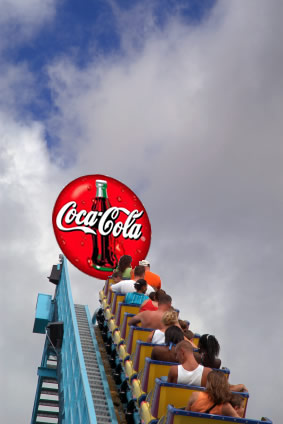Fear Factor Branding: The Best Ad Placement Ever
 One of the interesting tricks our brains play on us is to transfer physiological and emotional states that we are experiencing to something else going on at the same time. In Sway, authors Ori Brafman and Rom Brafman describe one of the more unusual experiments in behavior I’ve seen. In fact, it sounds like the perfect research boondoggle, as it required traveling to a remote location of incredible natural beauty. Oh, and did I mention that an attractive female research assistant was part of the experiment?
One of the interesting tricks our brains play on us is to transfer physiological and emotional states that we are experiencing to something else going on at the same time. In Sway, authors Ori Brafman and Rom Brafman describe one of the more unusual experiments in behavior I’ve seen. In fact, it sounds like the perfect research boondoggle, as it required traveling to a remote location of incredible natural beauty. Oh, and did I mention that an attractive female research assistant was part of the experiment?
Even if this road trip started off as a lark, the results it produced were quite interesting. Here’s the quick setup: the researchers traveled to Capilano Canyon in Vancouver, a scenic gorge that (at the time of the experiments) was conveniently traversed by two bridges: a sturdy and safe wooden one, and a scary, swaying rope bridge built in the 1800s and offering the possibility of falling up to 230 feet along its 450 foot length.
The researchers had a female assistant conduct a brief interview with random male hikers as they completed the crossing of each bridge. The ostensible reason was that researchers were studying the effect of scenic beauty on creative expression. After talking to each unwitting subject, the assistant offered to provide more information on the experiment, wrote her phone number down, and gave it to the subject. The same procedure was repeated with a male research assistant who also approached male hikers.
The male assistant received virtually no phone calls in the ensuing days. The female assistant, meanwhile, had her phone ring off the hook. Perhaps that’s no great surprise, but the interesting thing was the mix of calls that the female assistant received. Half of the hikers who had crossed the scary bridge called her, while only an eighth of those who used the sturdy wood bridge responded.
The conclusion of the researchers was that the swaying rope bridge had caused those crossing it to undergo physiological changes – their pulse rate increased, they perspired, adrenaline levels increased, and so on. When they were confronted by the female research assistant as they set foot on terra firma, the subjects subconsciously attributed this state of arousal to her presence. The hikers who had crossed the wood bridge had no such physiological change, and hence called with much less frequency.
Fear Factor Branding
Regular readers of Neuromarketing know I’m always trying to find the practical side of neuroscience and behavioral research, but figuring this one out was a bit tricky. Rope bridges and deep gorges are uncommon, to say the least. (Sadly, even the shaky rope Capilano Suspension Bridge has been replaced with a disgustingly safe steel cable version anchored in tons of concrete and featuring chain-link sides.) On the other hand, what ARE very common are scary amusement park rides like roller coasters. Over 300 million people visit such parks each year, and a healthy percentage of those partake in some kind of ride designed to get one’s adrenaline going. Is this an opportunity?
Here are three questions for which I don’t yet have good answers:
1) Would the adrenaline rush created by a scary ride transfer to a brand message, much like it did to the female research assistant in the bridge experiment?
2) If so, where should the ad placement be? In view of the rider while the ride is taking place? Or in sight as the rider exits the ride with wobbly knees and surging pulse?
3) Are there any negatives to combining branding and frightened customers?
Despite the fact that the effectiveness of such ads is speculative, I find the concept intriguing. What other opportunies can you think of for fear factor branding? New York taxis? IRS office sponsorships?
